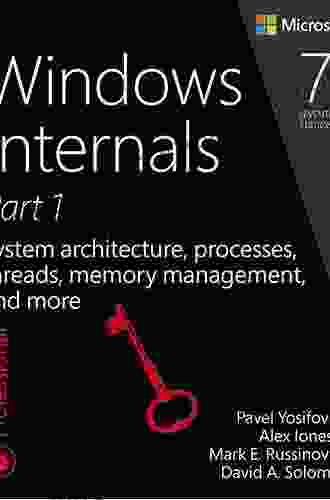Delving into the Intricacies of System Architecture: Processes, Threads, Memory Management, and More

System architecture forms the backbone of any modern computing system, governing the fundamental mechanisms that orchestrate hardware and software resources to execute user applications and system tasks. Understanding the intricate workings of system architecture is essential for software developers who aspire to create efficient, reliable, and scalable applications. In this comprehensive article, we will embark on a detailed exploration of core system architecture concepts, including processes, threads, memory management, and more.
4.8 out of 5
| Language | : | English |
| File size | : | 125313 KB |
| Text-to-Speech | : | Enabled |
| Screen Reader | : | Supported |
| Enhanced typesetting | : | Enabled |
| Word Wise | : | Enabled |
| Print length | : | 800 pages |
Processes
A process is a fundamental concept in operating systems, representing an instance of a running program. Each process possesses its own独立的virtual memory space, containing its instructions, data, and stack. The operating system manages processes, allocating resources, scheduling their execution, and providing mechanisms for process creation, termination, and communication.
Process States
Processes can exist in various states throughout their lifecycle, including:
- New: Process created but not yet started.
- Running: Instructions being executed by the CPU.
- Waiting: Waiting for an event or resource to become available.
- Terminated: Process has completed execution or terminated abnormally.
Process Control Blocks (PCBs)
The operating system maintains a Process Control Block (PCB) for each active process, containing vital information such as:
- Process ID
- Process state
- Memory management information
- Scheduling information
Threads
A thread is a lightweight process that shares the same memory space as its parent process. Multiple threads can execute concurrently within a single process, allowing for parallelism and improved performance. Threads are managed by the operating system, which schedules their execution and ensures that they do not interfere with each other.
Benefits of Threads
* Concurrency: Threads allow multiple tasks to execute simultaneously, maximizing resource utilization. * Shared Memory: Threads share the memory space of their parent process, simplifying data sharing and communication. * Context Switching: Switching between threads is faster than switching between processes, reducing overhead.
Memory Management
Memory management is a critical aspect of system architecture, ensuring that processes have access to the necessary memory resources to execute their instructions and store data. Modern operating systems employ various memory management techniques, including:
Virtual Memory
Virtual memory allows processes to access more memory than is physically available by utilizing a combination of main memory (RAM) and secondary storage (disk). When a process accesses a virtual memory address, the operating system checks if the corresponding page of physical memory is present. If not, it retrieves the page from disk and loads it into memory.
Paging
Paging is a virtual memory technique that divides physical memory into fixed-size pages. When a process accesses a virtual memory address, the operating system translates it to a physical address and checks if the corresponding page is in memory. If not, it fetches the page from disk and replaces one of the existing pages in memory.
Segmentation
Segmentation is another virtual memory technique that divides the process's virtual memory into variable-size segments. Each segment can have different access permissions and protection attributes, enhancing security and modularity.
Address Translation
The operating system uses a Memory Management Unit (MMU) to translate virtual memory addresses into physical memory addresses. The MMU maintains a page table that maps virtual pages to physical pages, facilitating efficient address translation and memory management.
Concurrency and Synchronization
Concurrency refers to the simultaneous execution of multiple processes or threads within a system. To ensure that concurrent processes and threads do not interfere with each other, synchronization mechanisms are employed.
Deadlocks
Deadlocks occur when two or more processes or threads wait indefinitely for each other to release a resource, creating a circular dependency. Deadlocks can be prevented using techniques such as lock ordering and deadlock detection and recovery.
Semaphores
Semaphores are synchronization primitives that allow processes or threads to control access to shared resources. A semaphore can be incremented to allow access or decremented to block access, preventing concurrent processes from accessing the same resource simultaneously.
Message Queues
Message queues are synchronization mechanisms that allow processes or threads to communicate and exchange data asynchronously. Processes or threads can send messages to a queue, and other processes or threads can receive messages from the queue, facilitating inter-process communication.
Shared Memory
Shared memory is a synchronization technique that allows multiple processes or threads to access and modify the same memory region. Shared memory simplifies inter-process communication and data sharing, but requires careful synchronization to prevent data corruption.
Understanding system architecture is fundamental for software developers to create efficient, reliable, and scalable applications. This comprehensive article has provided an in-depth exploration of core system architecture concepts, including processes, threads, memory management, concurrency, and synchronization. By mastering these principles, developers can harness the full potential of modern computing systems and deliver exceptional software solutions.
4.8 out of 5
| Language | : | English |
| File size | : | 125313 KB |
| Text-to-Speech | : | Enabled |
| Screen Reader | : | Supported |
| Enhanced typesetting | : | Enabled |
| Word Wise | : | Enabled |
| Print length | : | 800 pages |
Do you want to contribute by writing guest posts on this blog?
Please contact us and send us a resume of previous articles that you have written.
 Top Book
Top Book Novel
Novel Fiction
Fiction Nonfiction
Nonfiction Literature
Literature Paperback
Paperback Hardcover
Hardcover E-book
E-book Audiobook
Audiobook Bestseller
Bestseller Classic
Classic Mystery
Mystery Thriller
Thriller Romance
Romance Fantasy
Fantasy Science Fiction
Science Fiction Biography
Biography Memoir
Memoir Autobiography
Autobiography Poetry
Poetry Drama
Drama Historical Fiction
Historical Fiction Self-help
Self-help Young Adult
Young Adult Childrens Books
Childrens Books Graphic Novel
Graphic Novel Anthology
Anthology Series
Series Encyclopedia
Encyclopedia Reference
Reference Guidebook
Guidebook Textbook
Textbook Workbook
Workbook Journal
Journal Diary
Diary Manuscript
Manuscript Folio
Folio Pulp Fiction
Pulp Fiction Short Stories
Short Stories Fairy Tales
Fairy Tales Fables
Fables Mythology
Mythology Philosophy
Philosophy Religion
Religion Spirituality
Spirituality Essays
Essays Critique
Critique Commentary
Commentary Glossary
Glossary Bibliography
Bibliography Index
Index Table of Contents
Table of Contents Preface
Preface Introduction
Introduction Foreword
Foreword Afterword
Afterword Appendices
Appendices Annotations
Annotations Footnotes
Footnotes Epilogue
Epilogue Prologue
Prologue Brittany White
Brittany White Twylla Johnson
Twylla Johnson Barbara J Saffir
Barbara J Saffir J Lynn Hicks
J Lynn Hicks Steven Erikson
Steven Erikson Stephen Graham Jones
Stephen Graham Jones W Michael Gear
W Michael Gear Vinay Singh
Vinay Singh Daisy Rose
Daisy Rose Michael Martin
Michael Martin Stephen M Caliendo
Stephen M Caliendo Zoe Moore
Zoe Moore C Z Dunn
C Z Dunn Gurcharan Das
Gurcharan Das Cassandra Jade
Cassandra Jade Fumiaki Shingu
Fumiaki Shingu Sparkles 4 Kids
Sparkles 4 Kids Hardik Ashwin Pandya
Hardik Ashwin Pandya Elle Marr
Elle Marr James Kale Mcneley
James Kale Mcneley
Light bulbAdvertise smarter! Our strategic ad space ensures maximum exposure. Reserve your spot today!

 Jack PowellAve Maria Bach Gounod Alto Saxophone Solo With Piano Accompaniment: Exploring...
Jack PowellAve Maria Bach Gounod Alto Saxophone Solo With Piano Accompaniment: Exploring...
 Gabriel Garcia MarquezStop Smoking, Drug Use, Overeating, and More Today: Reclaiming Your Health...
Gabriel Garcia MarquezStop Smoking, Drug Use, Overeating, and More Today: Reclaiming Your Health...
 Gage HayesBleach Vol Quincy Archer Hates You: A Comprehensive Exploration of the Quincy...
Gage HayesBleach Vol Quincy Archer Hates You: A Comprehensive Exploration of the Quincy... Barry BryantFollow ·7k
Barry BryantFollow ·7k Stephen FosterFollow ·16.9k
Stephen FosterFollow ·16.9k John MiltonFollow ·10.9k
John MiltonFollow ·10.9k Forrest BlairFollow ·8.1k
Forrest BlairFollow ·8.1k Jimmy ButlerFollow ·17.9k
Jimmy ButlerFollow ·17.9k Rudyard KiplingFollow ·16.9k
Rudyard KiplingFollow ·16.9k Marvin HayesFollow ·12k
Marvin HayesFollow ·12k Davion PowellFollow ·3.1k
Davion PowellFollow ·3.1k

 Vernon Blair
Vernon BlairThe Woman I Met in My Dream: An Unforgettable Night of...
As the veil of night...

 Carlos Fuentes
Carlos FuentesThe Ultimate Guide to Healthy Eating for Toddlers: Meal...
As a parent of a...

 Peter Carter
Peter CarterInside My Autistic Mind: A Journey of Self-Discovery and...
Autism spectrum disorder (ASD) is a...

 Isaac Asimov
Isaac AsimovA Journey Through Jane Austen's Literary Masterpieces:...
Jane Austen, the renowned English...

 Hank Mitchell
Hank MitchellAdvancements in Textiles: Science and Technology by...
The textile...

 Troy Simmons
Troy SimmonsRecovery Road: An Odyssey of Hope and Redemption by...
Recovery Road is a...
4.8 out of 5
| Language | : | English |
| File size | : | 125313 KB |
| Text-to-Speech | : | Enabled |
| Screen Reader | : | Supported |
| Enhanced typesetting | : | Enabled |
| Word Wise | : | Enabled |
| Print length | : | 800 pages |






